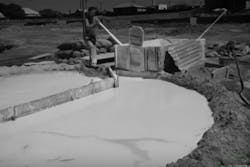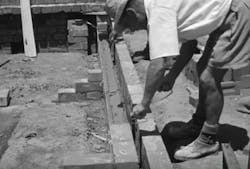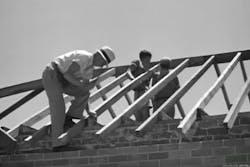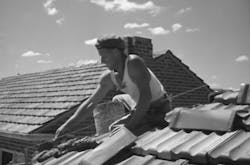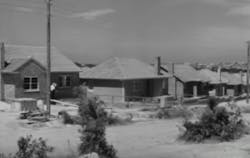This old school training film shows some familiar and unfamiliar construction methods once used down under.
Thanks to the National Film Board of Australia the methods used to construct brick homes in the mid-1940s won’t be lost when the last tradesman who worked on them is gone. This film was intended to train veterans returning from WWII.
It’s amazing how much of a project can be seen in a mere 10 minutes. Here’s a rundown (and my comments) on what the film contains:
(1:00) Seems like a lot of rebar for a footing built in those days—though maybe not so much considering the weight of the masonry that will go above.
(1:20) This looks to be a good size development. How else to explain them bringing a batch plant to mix concrete on site?
(2:05) I’ve read about slaking lime on site in old plastering books but never seen it done. The workers make a “pond” and fill it with water and quicklime, which is very dangerous stuff. After soaking a few days (slaking) it is converted to Calcium Hydroxide, which can be mixed with sand and made into mortar.
(2:35) The damp course acts as a capillary break that prevents moisture from rising into the wall from the ground. It’s hard to tell what kind of membrane they’re using—looks like it’s lead.
(2:50) I’m most familiar with veneer brick construction and older solid brick construction where the brick is solid through the wall. On this house there is an air gap between the inner and outer courses of brick. And that gap, along with the space under the first floor, is ventilated. The gap between inner and outer wall probably works like a modern rain screen.
(3:10) It’s interesting to see the main waste lines go in. They’re tile so the work is as much like masonry as plumbing.
(3:53) Metal ant caps are applied to piers to prevent white ants (termites) from getting into the floor beams.
(4:10) Lead flashing is installed at the bottoms of the rough openings for windows.
(4:40) More lead flashing at the tops of window openings.
(4:50) That guy in the fancy suit? You guessed it—the architect.
(5:18) The carpenters show up to frame the roof and begin to cut the roof rafters—with hand saws of course.
(5:30) Using a strong back to support very small ceiling joists from above.
(6:25) The tradesman who installs the gutters is referred to as a “roof plumber”. Later he step flashes the chimney.
(6:40) Hard to believe such a lightly framed roof can hold so much heavy roof tile.
(7:53) The cap tiles for the hips and ridge are mortared into place. Working from below the tiler uses copper wire to tie the rest of the tiles to the purlins.
(9:57) The finished house and the ones surrounding it are very nice. I’d have been happy to live there in 1946..
—David Frane is a freelance editor and a good buddy of ours. Formerly, he was editor of Tools of the Trade magazine and website. He lives in Northern California.
About the Author
David Frane
David Frane is a freelance editor and a good buddy of ours. Formerly, he was the editor of Tools of the Trade magazine and website. He lives in Northern California.

